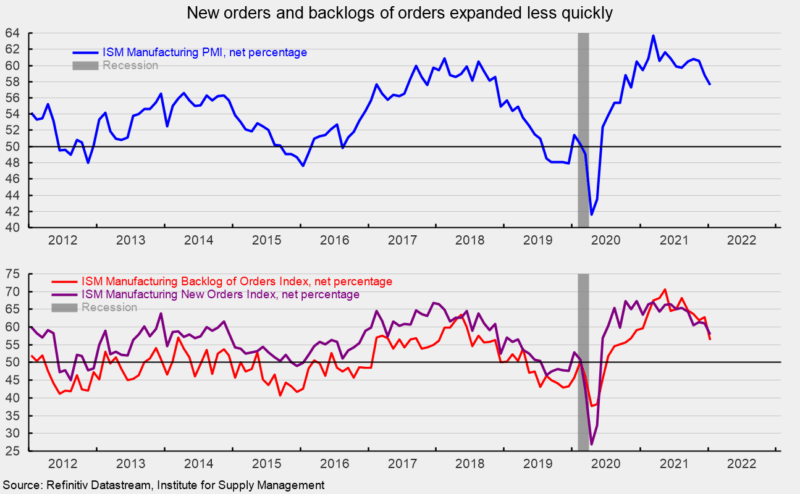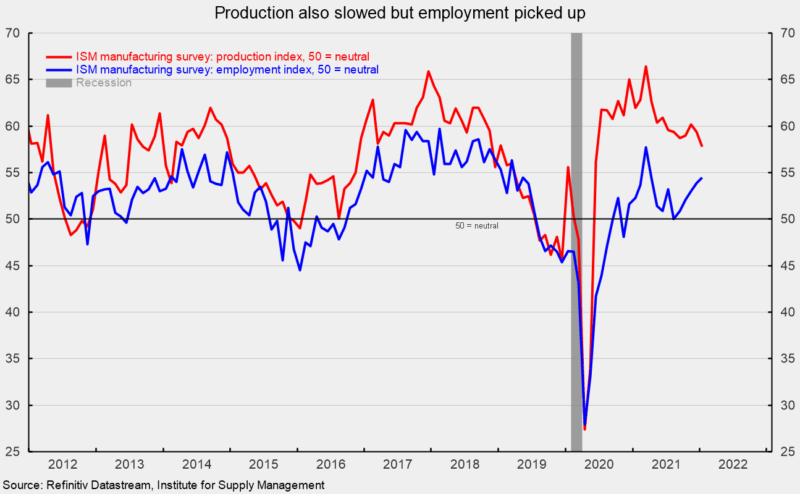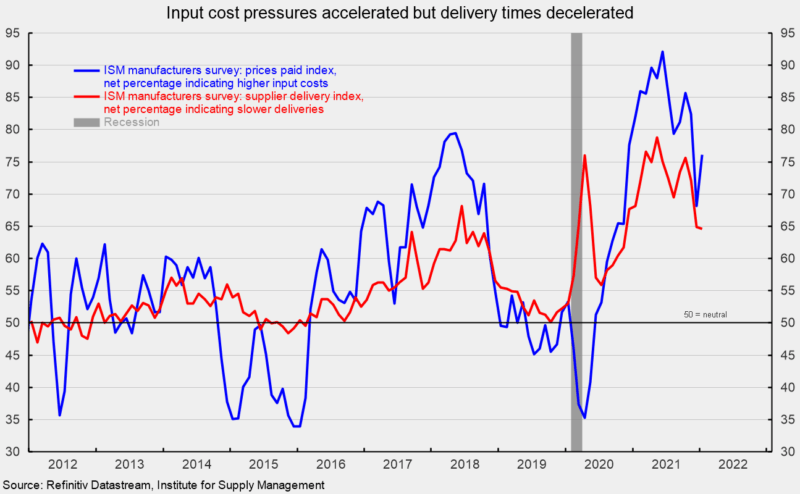Production Constraints Slowed Expansion in the Manufacturing Sector in January
The Institute for Supply Management’s Manufacturing Purchasing Managers’ Index fell to 57.6 in January, off 1.2 points from 58.8 percent in December. January is the 20th consecutive reading above the neutral 50 threshold but the third month in a row of slower expansion (see top of first chart). The survey results suggest that the manufacturing sector continues to expand but that labor and material constraints continue to hamper growth.
The new orders index fell 3.1 points to 57.9 percent in January. It has been above 50 for 20 consecutive months but fell below 60 for the first time since September 2020 (see bottom of first chart). The new export orders index, a separate measure from new orders, rose slightly to 53.7 versus 53.6 in December. The new export orders index has been above 50 for 19 consecutive months.
The Backlog-of-Orders Index decreased in January, coming in at 56.4 versus 62.8 in December (see bottom of first chart). This measure has pulled back from the record-high 70.6 result in May 2021 but has been above 50 for 19 consecutive months. The index suggests manufacturers’ backlogs continue to rise but at a slowing pace.
The Production Index registered a 57.8 percent result in January, a drop of 1.6 points from December. The index has been above 50 for 20 months but is now at the lowest level since June 2020 (see second chart).
The Employment Index rose again in January, posting its fifth consecutive increase and fourteenth consecutive reading at or above the neutral 50 level, rising to 54.5 percent (see second chart). That is the strongest result since March 2021. The run of increases and results above neutral may be an early indication that some of the labor issues plaguing production could start to ease in coming months.
The Bureau of Labor Statistics’ Employment Situation report for January is due out on Friday, February 4th. Consensus expectations are for a gain of 153,000 nonfarm payroll jobs including the addition of 25,000 jobs in manufacturing.
Customer inventories in January are still considered too low, with the index coming in at 33.0. That is up 1.3 points from December and is the highest level since January 2021 (index results below 50 indicate customers’ inventories are too low). The index has been below 50 for 64 consecutive months. Insufficient inventory is a positive sign for future production.
The index for prices for input materials rebounded in January, jumping 7.9 points to 76.1 percent versus 68.2 percent in December (see third chart). The index is down from a recent peak of 92.1 in June 2021 but still at a high level. Meanwhile, the supplier deliveries index registered a 64.6 result in January, down 0.3 points from the December result. The drop suggests deliveries slowed again in January but at a slightly slower pace. While both of these indexes remain elevated by historical comparisons, they are down significantly over the last few months, possibly suggesting that some of the issues restraining supply may be easing. Progress is also reflected in some of the comments made by respondents to the survey though most comments still highlight significant supply chain and/or labor constraints.
“While there has been some improvement in materials making it to our factories and logistics centers, we are still constrained by (a lack of) qualified labor. Orders so far are not being cancelled, but we are concerned that customers may be losing patience.” [Computer & Electronic Products]
“The supply chain crunch may be loosening a bit; however, specific original equipment manufacturer (OEM) parts and equipment now have lead times that we have not experienced before.” [Nonmetallic Mineral Products].
Overall, demand for the manufacturing sector remains robust but labor difficulties, materials shortages, and logistical problems continue to hamper the ability to meet that demand in many areas. While there are early signs of some easing, new waves of Covid threaten to extend the period of normalization and sustain upward pressure on prices.








